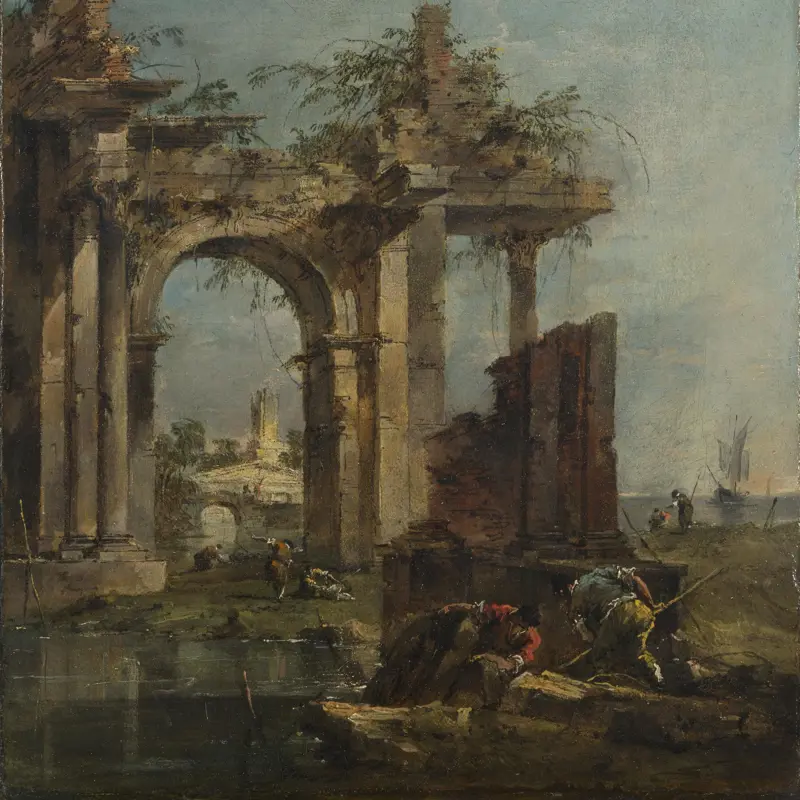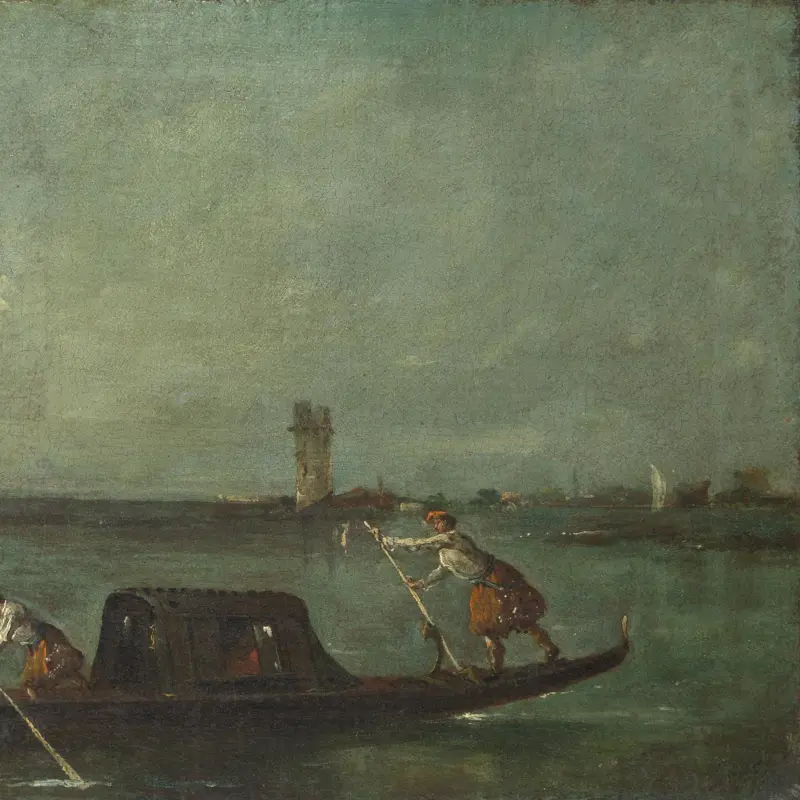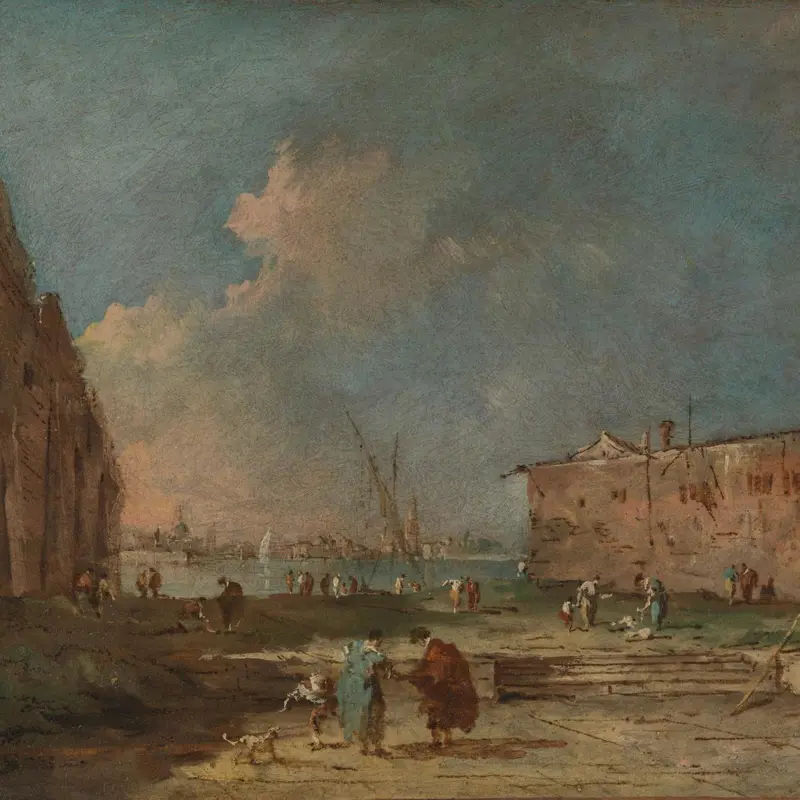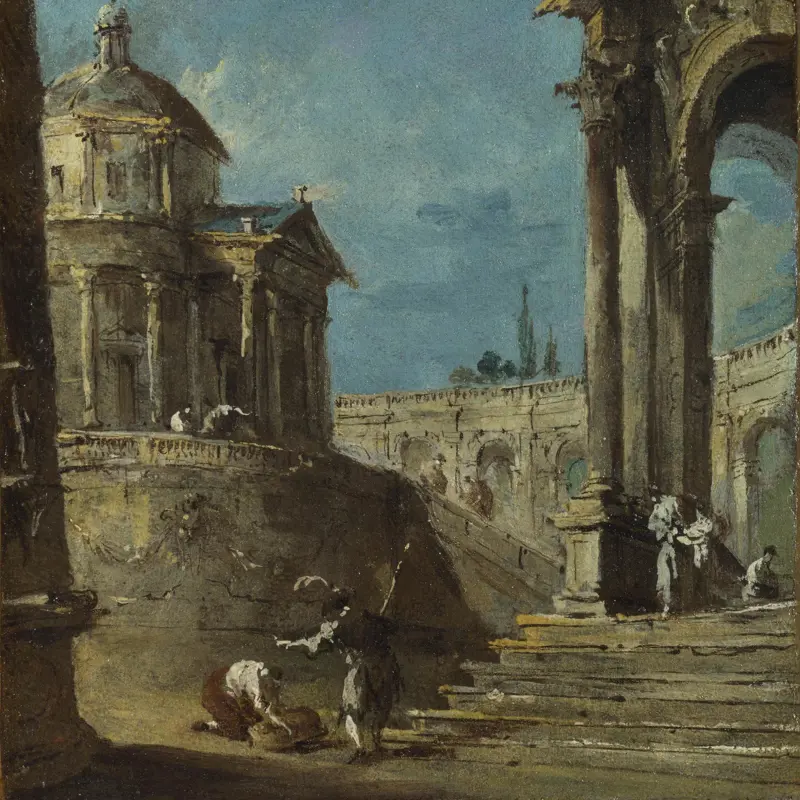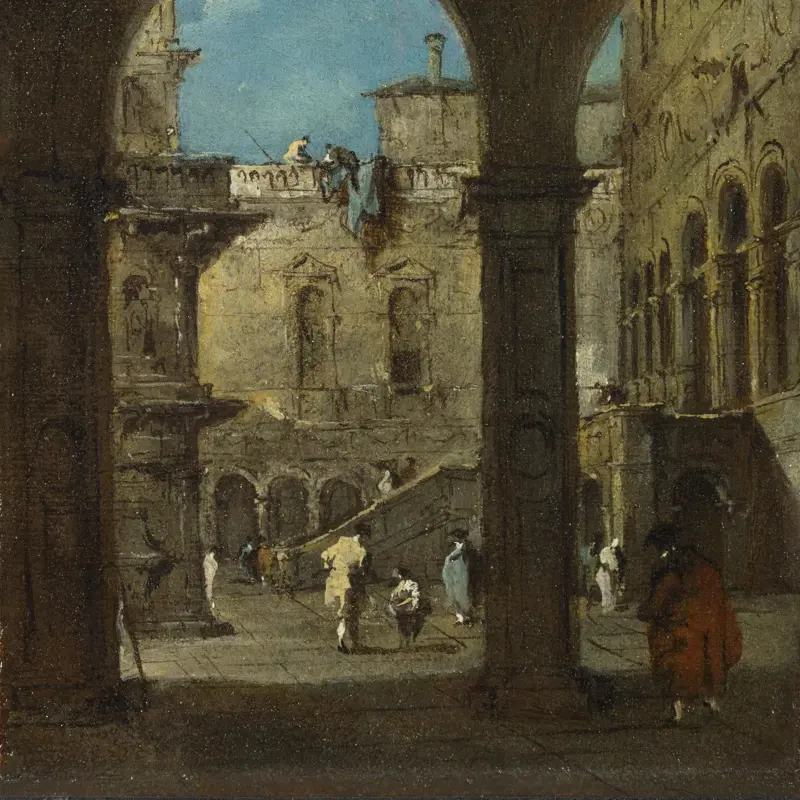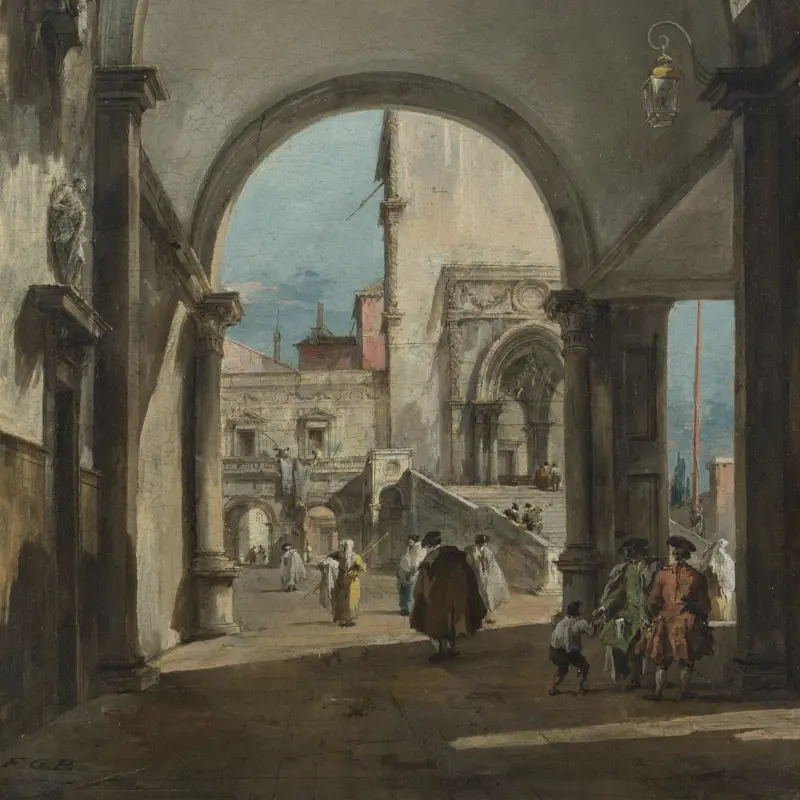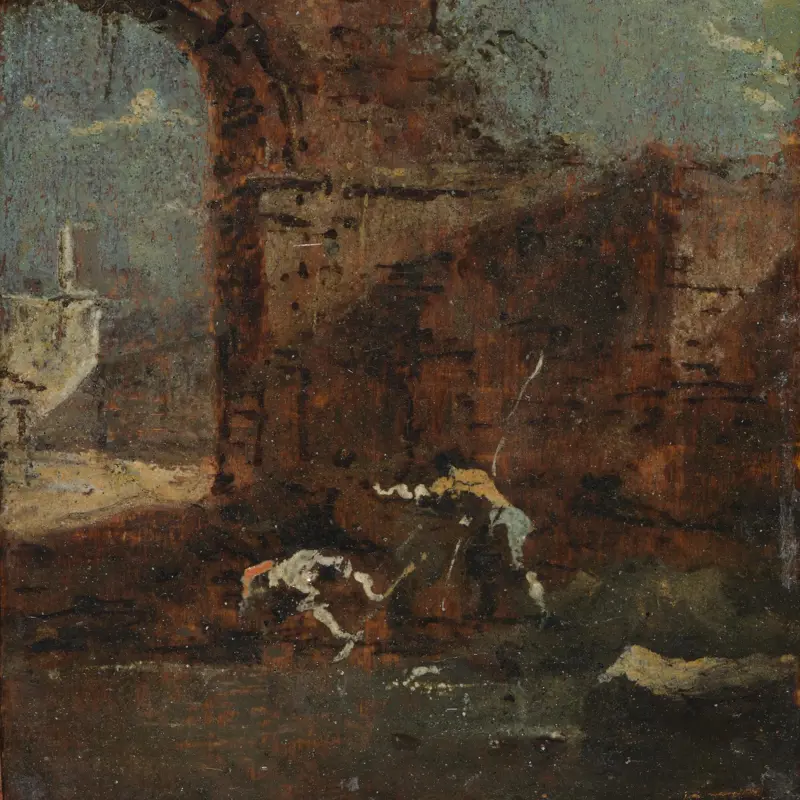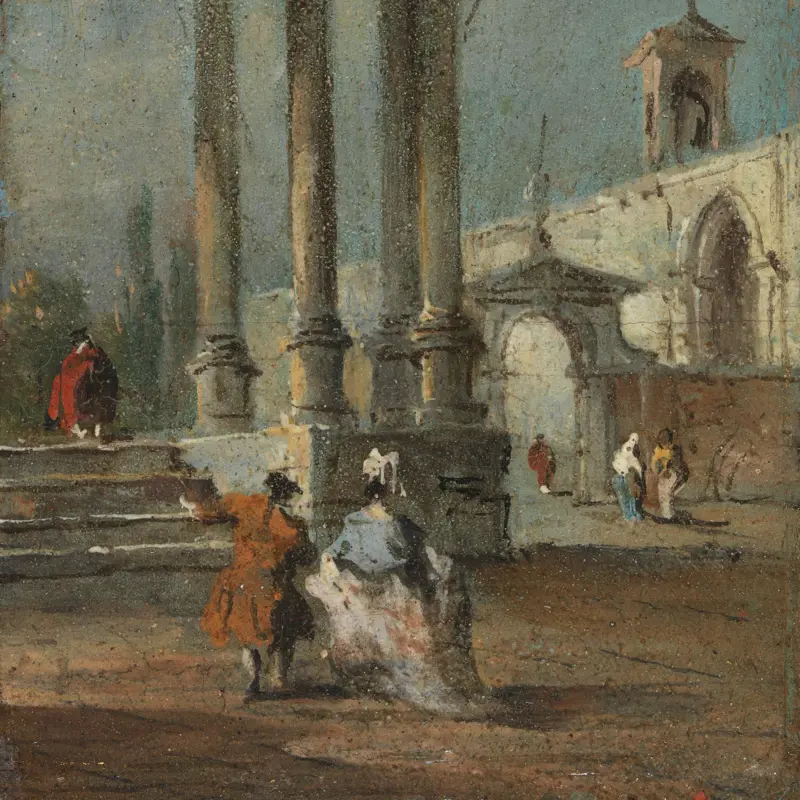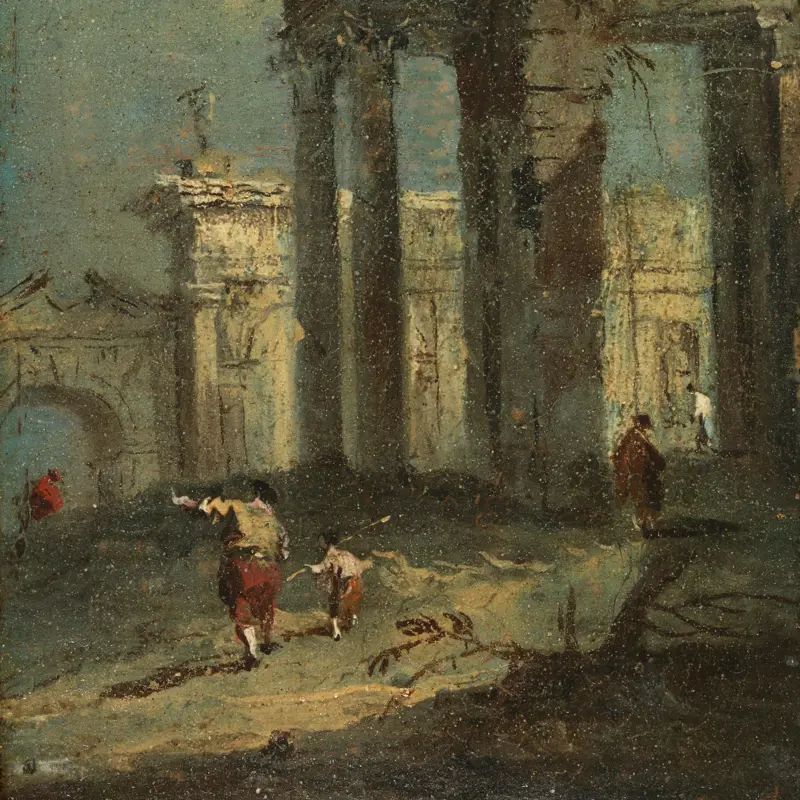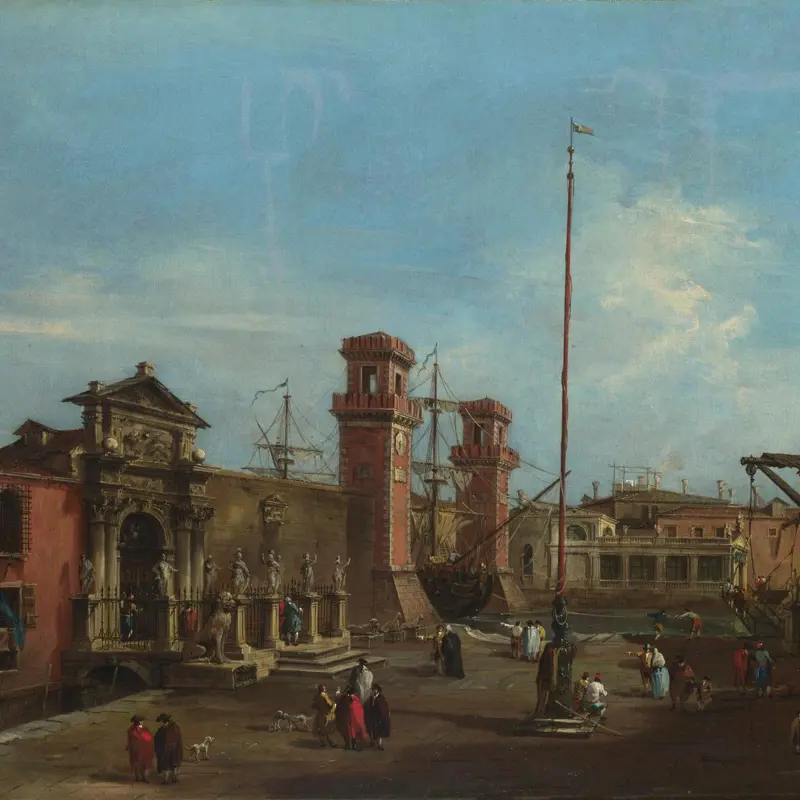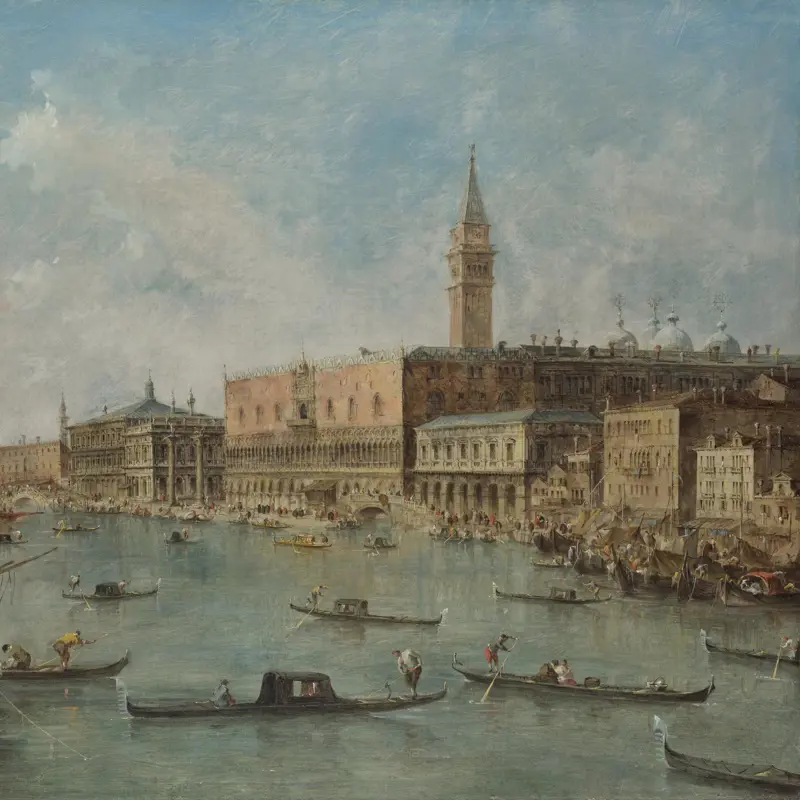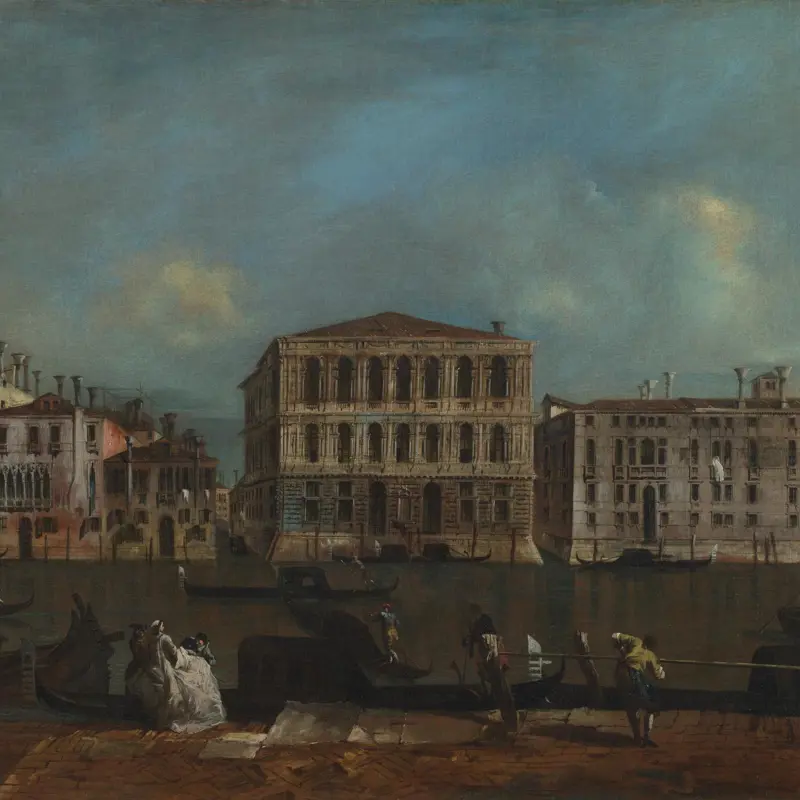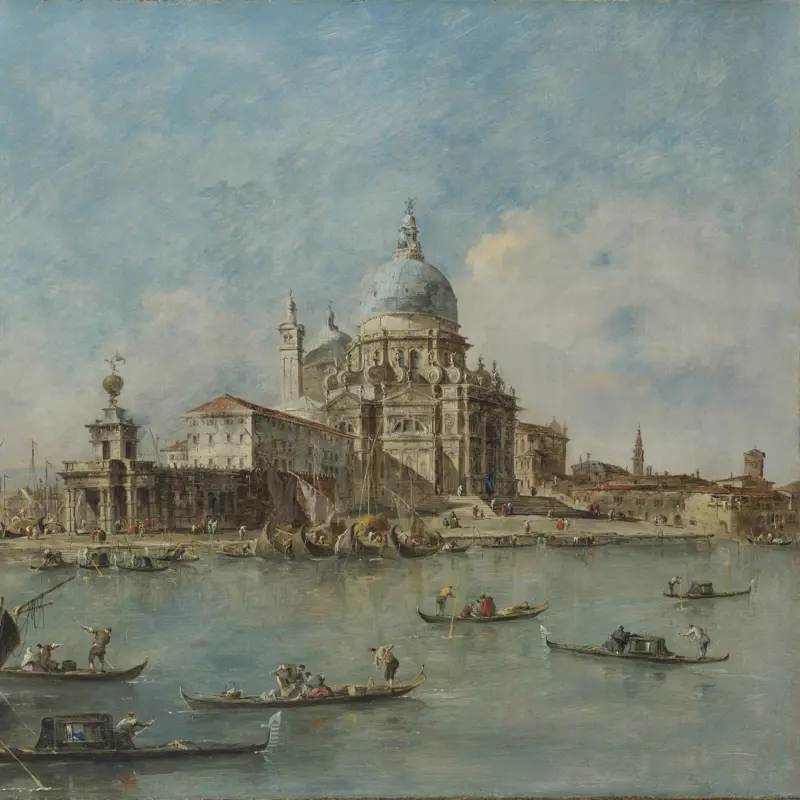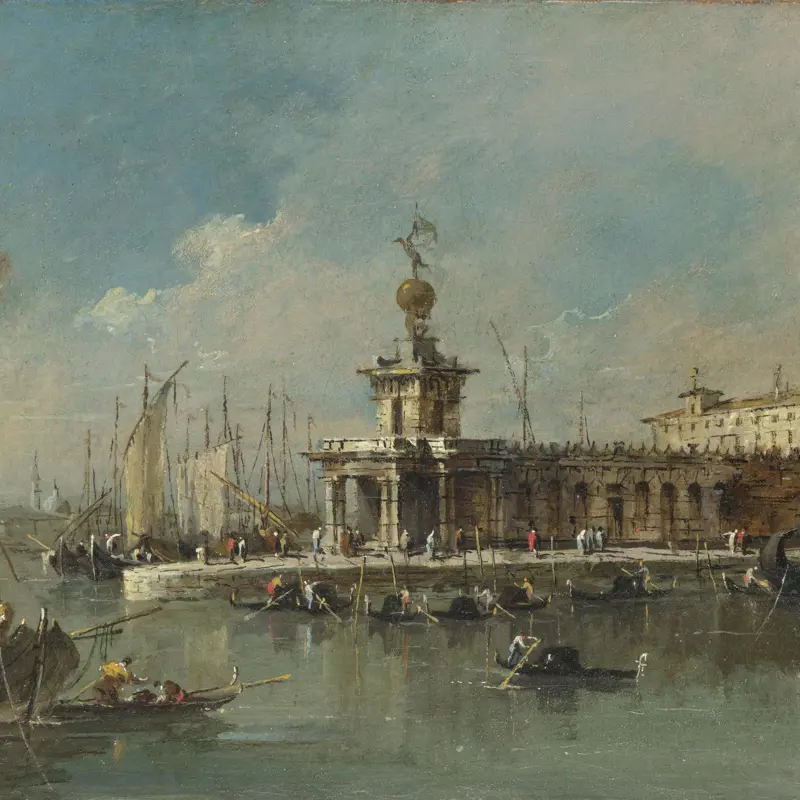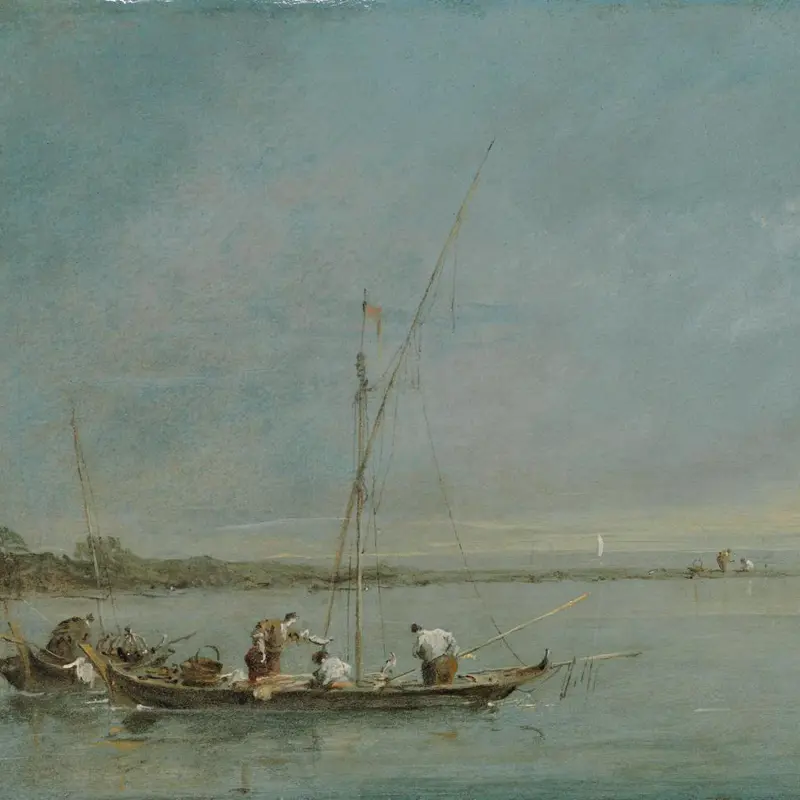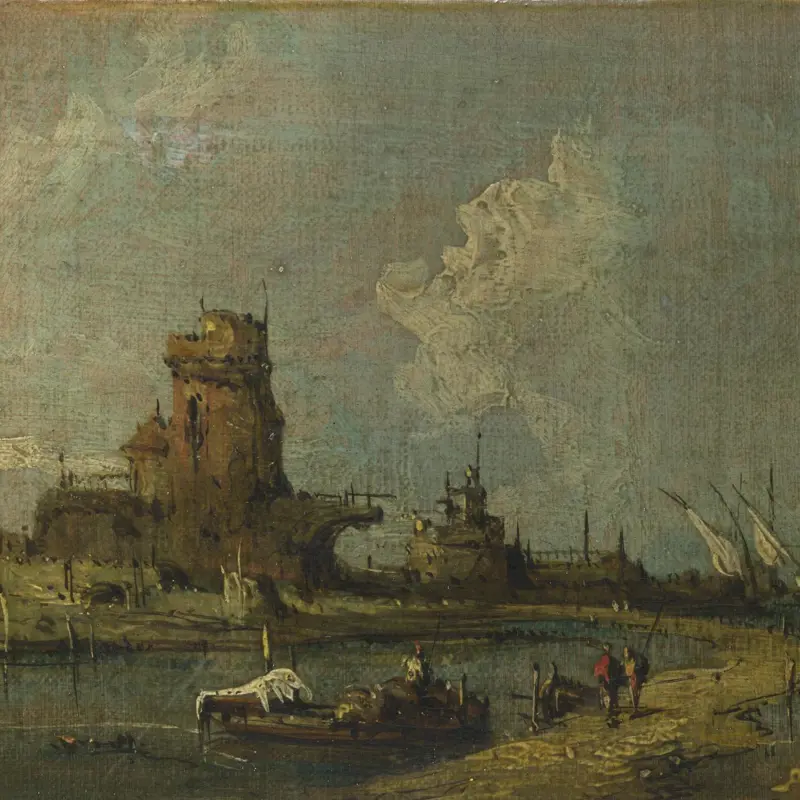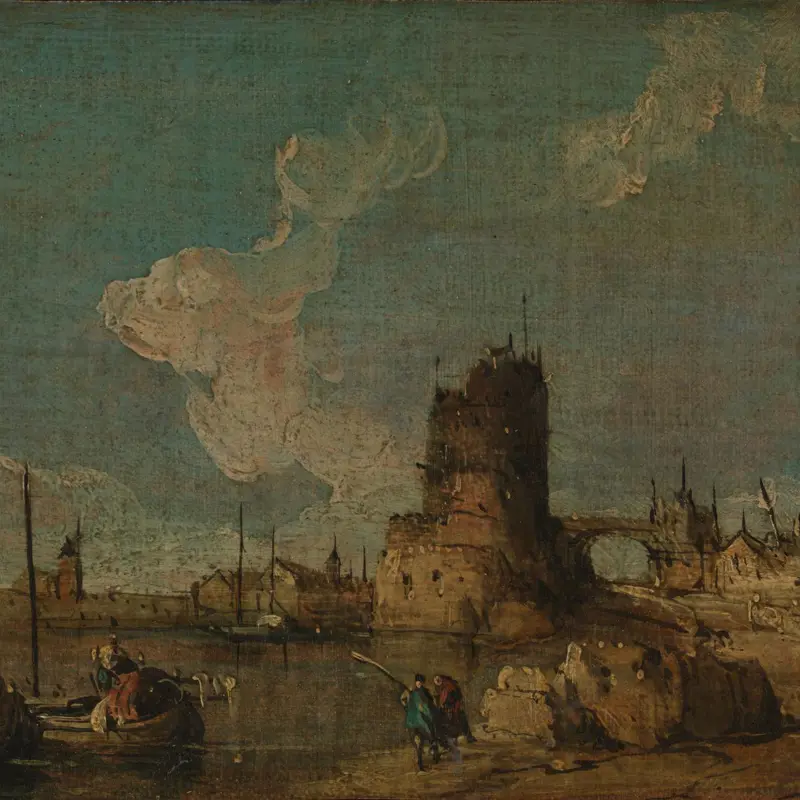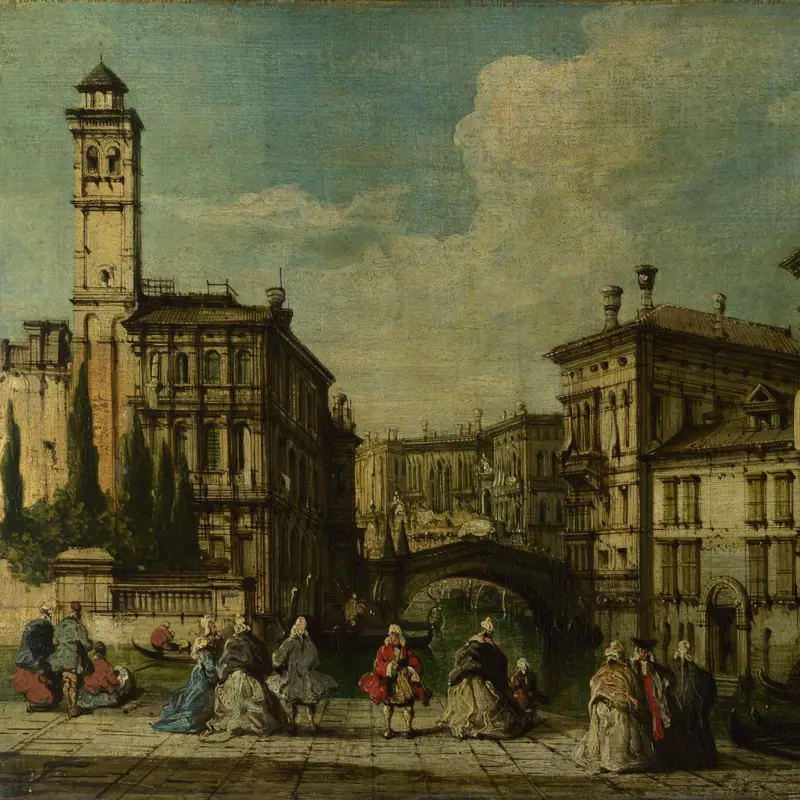Francesco Guardi was, after Canaletto, the main painter of views of Venice in the 18th century. His early figurative paintings were carried out in association with his brother, Gian Antonio, but in about 1760 Guardi turned to view painting. Following Canaletto he recorded both the architecture of the city and the celebrations of its inhabitants in interior and exterior scenes. These works brought him great success.
Francesco Guardi was born in Venice, the son of a minor painter, Domenico Guardi. In 1719 his sister married Giovanni Battista Tiepolo, who may have influenced the vivacity and bright colouring of Guardi's figures.
While Guardi followed Canaletto in producing views or vedute, he soon developed his own style, based on a freer handling of paint. He took particular pleasure in rendering the vibrant atmosphere of Venetian light and its dazzling effect on water.
The more 'impressionistic' approach of Guardi also found expression in small-scale imaginary scenes or capricci, of which there are many surviving examples, such as 'An Architectural Caprice'.
Francesco Guardi
1712 - 1793
Works by Francesco Guardi
(Showing 6 of 23 works)
Small figures – traders returning home from market or a fishing trip – animate this little scene, but also serve as a measure of scale, alerting us to the size of the ruins. This is an imaginary scene known as a capriccio, but Guardi took inspiration from known buildings – the arch with a suspend...
Not on display
This imaginary scene reflects an eighteenth-century fascination with ruins. In it, a once glorious but now ruined folly has been positioned on one of the islands in the Venetian lagoon. Two men dig energetically beside the classical arch, a scene repeated in other paintings by Guardi. He has used...
Not on display
Two gondoliers wearing traditional carnival costumes propel their boat across the Venetian lagoon, their oars stirring the water, their passengers sheltered by a canopy. On the horizon, sails catch the breeze.In the distance is the tower of Malghera, near Mestre on the mainland (Guardi’s larger V...
Not on display
This is most likely a view of daily life in Venice during the second half of the eighteenth century, rather than an invented capriccio, though the actual site has not yet been identified. The Guidecca, Chioggia and Murano (districts and islands of Venice) have all been suggested.Men chatting, wom...
Not on display
This theatrical scene, with its stage-like setting of dramatic buildings that loom over the figures, was imagined by Guardi. The building on the left may be based on an unused design for Venice’s Rialto bridge by Andrea Palladio, a sixteenth-century architect. Guardi probably studied the design a...
Although capricci views like this one show scenes that are essentially imaginary, Guardi often used details of real buildings in his. The staircase here is based on the one in the courtyard of the Doge’s Palace in Venice, though Guardi has removed some of its statues. He also reduced the size of...
This capriccio, or architectural fantasy, is a patchwork of features taken from different buildings in Venice: the archway in the foreground is from the Torre dell'Orologio (clock tower) while the buildings and staircase beyond are from the inner courtyard of the Doge’s Palace. Guardi has exagger...
Not on display
This tiny picture, measuring only 10 by 6 cm, is framed with two other views of picturesque ruins in imaginary Italian settings (such paintings are known as capricci). One shows an elegant couple and the other depicts a man and child surrounded by soaring architecture. In the foreground of this s...
Not on display
This is one of three tiny pictures that have been grouped together since the early nineteenth century (the others show a man and child in a landscape with a derelict folly, and hard-working men beside a pool). It shows an elegantly dressed couple heading towards a pillared ruined arch, which appe...
Not on display
A crumbling, overgrown archway towers above a man and a young child carrying a stick, who are picked out by warm sunlight. The eye is led into the scene by the contrast of light, which illuminates the white stone building beyond, and shade. The use of simple blocks of colour and black lines to su...
Not on display
We look down on a captivating crowd of people and across the Piazza San Marco, one of Venice’s most famous landmarks. Characterful figures draw us into the scene – like the elegant couple in black cloaks who stride across the square, the gentleman dressed in a red cloak and powdered wig or the ma...
Guardi’s shimmering brushwork gives this picture a magical quality. On the far side of the square, the facade of the Basilica di San Marco glows, while a blaze of sunlight warms the sky behind the Procuratie Vecchie, the offices of the Republic’s administration, to the left.Although the figures a...
Not on display
The Venetian Arsenal, a fortified shipyard and armoury, had been celebrated as a symbol of the Venetian Republic’s domination of the Mediterranean sea trade since the twelfth century. Its ornate gateway is decorated with statues of Greek and Roman gods; standing guard is the lion, a symbol of the...
Guardi delighted in capturing the charm of his beloved Venice, and here he has given it a soft, powdery appearance and dreamy atmosphere. Trade is the focus in the foreground – the basin of San Marco and the quayside is a hive of activity. Lively brushstrokes evoke the bustle of the city at work,...
Not on display
Beyond Venice’s Grand Canal, on the peaceful island of Guidecca in the easternmost part of the city, is the domed church of Santa Maria della Presentazione. Better known as the Zitelle, the church was built in the sixteenth century and attached to a foundling hospital for young girls (zitella is...
Guardi’s picture takes in the view across the Grand Canal, towards some of the grandest palaces in Venice: the imposing facade of the Palazzo Pesaro is in the centre and the Palazzo Corner della Regina at the far left.A funeral boat glides along the water, carrying churchmen and ornate burning ca...
Not on display
The huge dome of the church of S. Maria della Salute dominates the entrance of the Grand Canal. Just in front is the Dogana da Mar (Customs House), built in the 1670s and shaped like a ship’s bow. Above its entrance is a weathervane in the form of Fortune, a personification of the Venetian Republ...
Not on display
This scene shows the Dogana da Mar (Customs House), which was built in about 1677, and the entrance to the Grand Canal. Over the gateway to the canal is a golden globe with a weather vane in the shape of Fortune, personified as the mistress of the sea. With almost no land, Venice depended on mari...
This is one of of Guardi’s most serene paintings. The summery Venetian sky and the water of the lagoon merge almost seamlessly, broken only by a softly painted landscape and a few buildings. The tower of Malghera, the city’s ancient fortress, lay on the edge of the lagoon near Mestre, but the foc...
Not on display
Imitator of Francesco Guardi
An imaginary ruined castle or fortress, bathed in gentle sunlight, stands on a piece of land that juts into the water. A fishing boat is moored in a sheltered cove, and two figures – perhaps off fishing, as one holds a rod – walk past it along the water’s edge. A gentle breeze coming off the wate...
Not on display
Imitator of Francesco Guardi
A fortified town sits at the edge of a peaceful lagoon – we see just a few boats and a handful of people. These boats may be carrying supplies to and from Venice; for centuries, the city had profited from strong trading routes with mainland Italy and across the Mediterranean. The foreground figur...
Not on display
Imitator of Francesco Guardi
Venetian artists Canaletto and Guardi specialised in view paintings, which were so popular with local and foreign collectors in eighteenth-century Venice that countless imitations were made. These made their way, alongside genuine works by both artists, into art collections throughout Europe. Des...
Not on display
You've viewed 6 of 23 works


